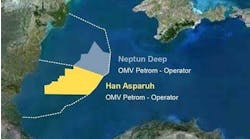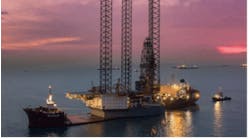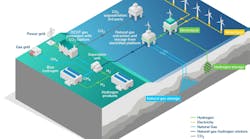As offshore wells are drilled in deeper water to deeper depths around the world, the selection of a subsea wellhead system remains a critical factor in meeting the drilling challenges.
Drilling operations for these areas will require subsea wellhead systems able to cope with ever-higher pressures, higher temperatures, heavier loads, and an increased number of casing strings. Tried-and-true large bore technology, with an additional structural foundation conductor and an additional string inside of BOP control, remains the equipment of choice for deep wells in deepwater.
The large bore wellhead was designed to defeat unconsolidated ocean floor conditions and control shallow water flows both outside and through BOP control. Larger bore holes make it possible to run deeper large-diameter casing strings (16 in. [41 cm]) and 18 in. [46 cm]), which allow the installation of large bore production casing at record-setting depths.
The advantage of a variety of casing options, due to low fracture gradients, became clear as soon as deep holes were drilled in the Gulf of Mexico, but adding casing strings inside of BOP control was more troublesome. The industry already had conquered the addition of a 16-in. supplemental casing hanger system inside of 20-in. (51-cm) pipe attached to the bottom of the 18-3/4-in. (48-cm) wellhead. However, adding another casing string such as 18 in. to mitigate the problems associated with shallow water flows and extend a larger diameter wellbore to deeper depths was a tricky problem.
The minimum ID of a traditional 18-3/4-in. wellhead is 17-9/16 in. (45 cm) and must support both the heavy casing weight and the end load from a BOP stack test to be a 15,000 psi rated wellhead system. Thus, to pass an 18-in. casing string through a traditional wellhead would require a new solution.
When the minimum ID of the wellhead is opened to pass 18-in. casing and a slightly larger 18-in. casing hanger, the landing shoulder inside the wellhead becomes unusually small in order to support combined casing weight plus the end-load generated from a BOP stack test and still be rated to 15,000 psi.
Dril-Quip was the first in the industry to provide a solution, the company says.
“For Dril-Quip, the answer was obvious – introduce the same multiple load shoulder profile in the minimum ID to distribute the load over several shoulders that existed in the company’s first generation 18-3/4-in. 15,000 psi subsea wellheads,” says Mike Speer, manager of marketing and training of Dril-Quip.
The net result was an 18.510-in. (47-cm) minimum ID. By introducing 22 in. (56-cm) to replace the then-standard 20 in. attached to the bottom of the wellhead, the resulting system was able to maintain the maximum of flow-by required to run and install an 18-in. casing hanger and casing string through an 18-3/4-in. nominal wellhead. In addition, the 18-in. supplemental casing hanger system was designed with a single trip testable seal assembly to seal the annulus between the 22-in. and 18-in. casing strings.
Running tools to install all of the BigBore wellhead components have been correspondingly upgraded to carry the heavier casing loads required in these deep well applications.
Open bore subsea wellhead system in GoM depth records
The first BigBore Wellhead system was installed in 1999. The system has been deployed successfully setting a number of industry records in deepwater and deep well drilling operations in the GoM.
- In 2000, Shell installed the system in 7,790 ft (2,374 m) of water
- In 2001, BHP Billiton installed the system in 8,835 ft (2,693 m) of water
- Shortly thereafter, Unocal set a record with the system in 9,687 ft (2,956 m) of water
- By the end of 2001, Unocal again deployed the technology in 9,727 ft (2,965) of water
- In 2003, Chevron-Texaco installed the system in 10,011 ft (3,051 m) of water in the Alaminos Canyon in the GoM at a total depth from sea level to the bottom of the hole of over four mi (six km).
- In 2008, Murphy Oil spudded a well in the GoM in a record water depth of 10,141 ft (3,091 m) using Dril-Quip’s BigBore II subsea wellhead system.




